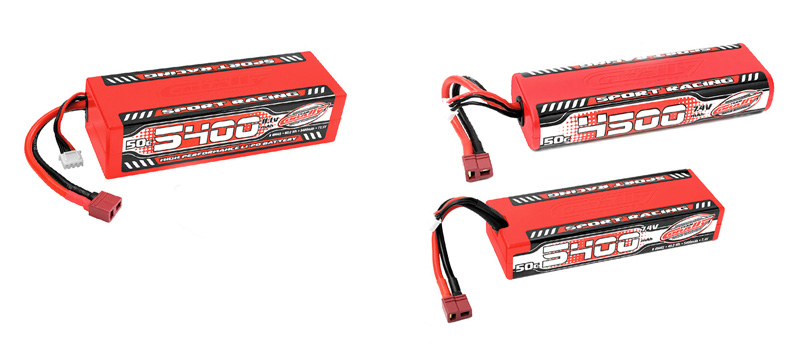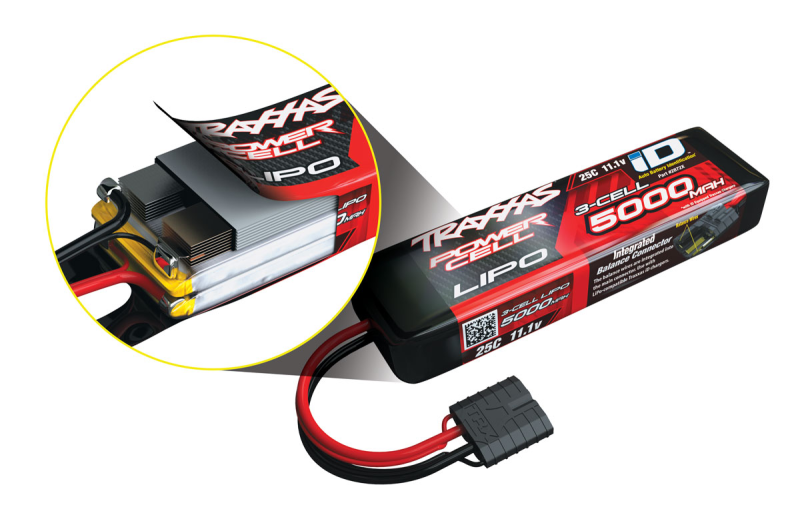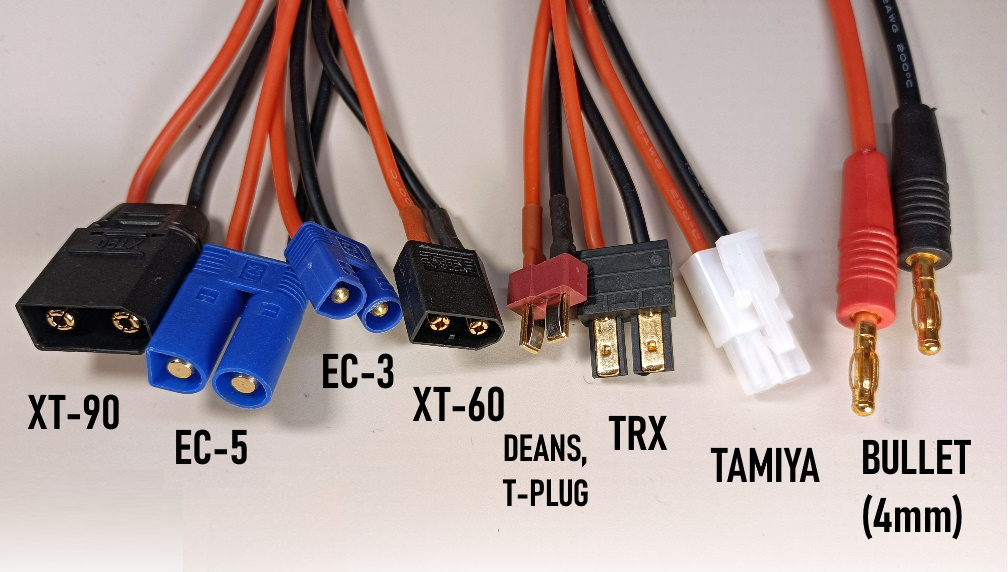Lipo-Battery Knowledge
Date Posted:8 January 2024
Lipo-Battery Guide

While some RTR cars are still delivered with NiMh (nickel metal hydride) batteries, and they can still be a good choice for beginners or specific uses, by and large, Lipo (lithium polymer) batteries have taken over the RC car market. Many RTR’s are either already delivered with them included, or the battery choice is left up to the customer, and in all RC car racing today Lipo batteries are used.
LiPo batteries come in a huge variety of type and size. But what do all the markings on a Lipo battery mean, and how do you know which is the right choice for you? Let’s take a look at some basic Lipo battery knowledge.
.jpg)
A Lipo battery is constructed from separate cells, all connected to form the specific battery. One Lipo cell has a nominal voltage of 3.7V. When connecting these in series, the voltage increases, meaning you get 7.4V for a 2 cell battery, 11.1V for a 3 cell battery, 14.8V for a 4 cell battery etc. Capacity on the other hand can be increased by connecting more cells in parallel.
On batteries, or in product descriptions for batteries, you see numbers or codes like 2S2P. These numbers are a way to describe the battery configuration in a short way, and in the example they mean that the battery has 2 cells (2S) connected in series, and 2 cells sets connected in parallel (2P).
Higher voltage means more power, higher capacity give longer runtimes. Here’s a table with the voltage for the Lipo types used for RC cars:
- 1S battery: 1 x 3.7V = 3.7V
- 2S battery: 2 x 3.7V = 7.4V
- 3S battery: 3 x 3.7V = 11.1V
- 4S battery: 4 x 3.7V = 14.8V
- 5S battery: 5 x 3.7V = 18.5V
- 6S battery: 5 x 3.7V = 22.2V
- 8S battery: 5 x 3.7V = 29.6V
In addition to "normal" Lipo batteries, there are also special LiHV, or High Voltage Lithium Polymer batteries available. These are very similar to normal Lipo batteries, but they allow you to charge the battery up to 4.35V per cell, while regular lipos must be charged up to 4.2V maximum.
.jpg)
Another important aspect of any Lipo battery is the C rating, which you will always again find on the battery label or product description. The C rating stands for discharge rate, and describes how fast a battery can be discharged safely. If a battery is rated at 50C and has a capacity of 5000mAh, it means that safely handle a discharge rate of 50 x 5000mAh = 250.000mAh = 250Ah. Meaning that this number is the maximum sustained load you can safely put on the battery. As you can see from the example, both the capacity and C rating are important for the actual discharge rate of a battery.
Many batteries today have two C ratings - a continuous rating, and a burst rating. The burst rating describes what the battery can handle in short bursts, and not continuously. Batteries are usually compared using the continuous rating and not the burst rating. The C rating can be useful to help you select a Lipo battery, but unfortunately many manufacturers overstate C values for marketing purposes, which means you can’t always trust it 100%.

Another very important aspect of a Lipo battery is IR, meaning Internal Resistance. As opposed to the other features we have mentioned, you will not find the IR rating stated anywhere on the battery. The internal resistance of a battery pack changes over time, and depending on conditions like temperature, so it would be impossible to give a correct number. That does not mean it isn't important though, as in some ways, the internal resistance is among the most important ratings for any battery.
To make it simple, we can describe IR as a measure of the difficulty a battery has delivering its energy to your motor and speed control. So the higher the IR number, the harder it is for the energy to reach them. In short, the internal resistance is a measure of how efficient the battery is.

Points need to consider when choosing a Lipo battery
- Size and connectors
This is the first thing to take into account, as you need to choose a battery with a physical size that actually fits in the car. You also need a battery with the right connectors for your car/charger. Of course connectors can be exchanged, but the easy solution is to buy a pack with the right connectors.
- Voltage
Battery voltage, or cell count, is another decision that you will need to make. Many cars and their electronics are made for a specific voltage, like a max 2S (7.4V) battery, but for some cars it’s up to you to choose among several alternatives. Higher voltage batteries makes more power, but are heavier and often more expensive. The most important thing is of course not to go over the voltage that your electronics are able to support. And there is no idea to go for a super expensive battery that makes your car so powerful that it is un-driveable.

- Capacity
What capacity you need is directly related to the size and weight of a car, as well as the motor used. With a light and small car, you will get enough runtime even with a low capacity battery pack. The more energy the car and electronics draw, the more capacity you will need to get decent runtime. A higher capacity battery will usually also cost more, so the choice comes down to a compromise between price and runtime.
- Discharge Rate
Using a battery with a discharge rate (C) that is too low can result in your battery being damaged. However, today most batteries sold have a high enough discharge rate for most uses. Remember that the maximum current output of a battery depends on the capacity and C rating. Therefore, the smaller the capacity of a battery, the higher the C rating needs to be.
- Hardcase
While most batteries for RC cars have a hard case, there are also soft case Lipo batteries available. For RC car use hardcase batteries is what we always recommend.
LiPo Charging Safety
There are a number of rules to follow when charging a LiPo battery.
The number one rule when charging a LiPo battery is to NEVER leave a charging LiPo unattended! Not even for a second. If you have to leave the charging area, then stop the charge.

The majority of LiPo fires happen during charging, and the deadly ones are usually a result of leaving the battery unattended.
Here are some other safety rules:
- Always check the connections before starting the charger.
- Charge outdoors, or in a well-ventilated area.
- Always have a fire extinguisher nearby when charging.
- Never charge the LiPo inside the device it is powering. Always remove it and place it in a safe area.
- Always charge a LiPo on a non-flammable surface.
- Never charge a damaged or ballooned LiPo.
- Never short circuit the output of a LiPo at any time, but especially during charging.
- Always have a fire extinguisher handy.
- Keep children and pets away from the area you are using to charge the LiPo.
- Keep away from flammable liquids or objects when charging.
- Never leave a charging LiPo battery unattended (I know I already said this, but it is so important that it is worth repeating).
- When charging your LiPo it is a good idea to have it inside a battery bag or other protective enclosure. And check the battery periodically for excess heat, it’s not uncommon for it to get a bit warm, but if it gets too hot to hold, then stop charging.
.jpg)
Proper Care & Treatment: Storage
We used to run our cars or airplanes until the batteries died, then just set the batteries on the shelf at home, waiting for the next time we could use them. We just stored them dead. But you should not do that with LiPo batteries. Nor should LiPo batteries be stored at full charge, either. For the longest life of the batteries, LiPos should be stored at room temperature at 3.8V per cell. Most modern computerized chargers have a LiPo Storage function that will either charge the batteries up to that voltage, or discharge them down to that voltage, whichever is necessary.

We recommend to our customers that they put their LiPo batteries in storage mode after every run. This isn't necessary each time, but it does build up good habits. If you do it every time, you don't have to worry about whether or not you remembered to put it in storage.
They should also be stored in a fireproof container of some sort. Most people tend toward leaving their LiPos in a LiPo bag, as they are portable and protect your workshop from catching fire should the LiPo combust. Others like to use empty ammo boxes, fireproof safes, and ceramic flower pots. Whatever you have (or can buy) that will prevent any fire from spreading will be worth it in the unlikely event that anything untoward should happen.
LiPo Battery Bags

These bags purport to be both explosion and fire-resistant, and on the surface, it sounds like they would be all you would need to safely store your batteries. But the truth is, they aren’t all that they are advertised to be.
These bags are made of cloth, usually with a metallic compound woven into them. They generally have either a zipper or a Velcro fastener, and they come in a wide assortment of sizes.
But despite their somewhat grandiose claims, they really can’t withstand the heat of a LiPo fire. At best, they will slow it down enough to allow you to grab your extinguisher. But left alone during a fire, they will quickly break down.
Now, don’t get me wrong, these LiPo bags do have their use. I use them when I’m charging a LiPo, an operation that is always supervised and for which a fire extinguisher is on hand. And I also use them to supplement my other storage solutions. And they are great for transporting a LiPo from its storage area to the device you are powering.
But, on their own, they don’t offer adequate safety, and shouldn’t be the only thing you rely upon to protect you from a LiPo that experiences a thermal runaway.
Disposing of a LiPo Battery
Before you can dispose of your LiPo battery, it needs to be completely discharged. Even a “dead” LiPo can hold a lot of energy, and it can catch fire if crushed in a garbage truck or trash compactor. After discharging the battery completely, you can dispose of it.
In many municipalities, you can simply throw it in with the rest of your trash, as it no longer contains any volatile or dangerous chemicals and has very little lithium. But in some areas, you will need to take it to an authorized disposal facility.
Make sure you check with the proper authorities to determine the proper disposal method for your area. In my community, we have a bi-annual hazardous goods disposal at the city hall, and they take all batteries, including LiPo batteries.
Conclusion
.jpg)
When it comes to using LiPo batteries, nothing is more important than safety. LiPo batteries are powerful devices that need to be treated with respect and handled with care. If you observe proper handling, charging, balancing, and storage techniques, these batteries can last a long time and provide a virtually unlimited source of power for your projects.
Related products from I'M RC
Next please remember to have fun, and if you don't know something, ask questions! Find your local hobby shop or R/C club — or even post your question to one of the hundreds of R/C message boards on the interwebs. The only dumb question is the one you don't ask!
Best Regards,

Add: No 3/6 Gladstone Road, Castle Hill, NSW, 2154
We’re dedicated to providing you with the best RC&Hobby experiences


 Onroad
Onroad
 Offroad
Offroad
 Kits
Kits
 Electric
Electric
 Ready To Race (RTR)
Ready To Race (RTR)
 Nitro
Nitro
 Drift
Drift
 Rock Crawler
Rock Crawler
 Offroad
Offroad
 Pickup
Pickup
 Buggy
Buggy
 Monster
Monster
 Sailing
Sailing
 Jet
Jet
 RTR
RTR
 Electric
Electric
 High Speed
High Speed
 Individual Cars
Individual Cars
 Sets
Sets
 Locomotive & Carriages
Locomotive & Carriages
 Spare Tracks
Spare Tracks
 Sets
Sets
 Kits
Kits
 ACADEMY
ACADEMY
 AIRFIX
AIRFIX
 ALBION METALS
ALBION METALS
 APC
APC
 ARRMA
ARRMA
 ARTESANIA
ARTESANIA
 AXIAL
AXIAL
 BALSA
BALSA
 BBURAGO
BBURAGO
 BLACKZON
BLACKZON
 BLADE
BLADE
 BOB SMITH
BOB SMITH
 BOLLY
BOLLY
 CASTLE CREATIONS
CASTLE CREATIONS
 DELUXE MATERIALS
DELUXE MATERIALS
 DRAGON
DRAGON
 DUALSKY
DUALSKY
 DUBRO
DUBRO
 DUMAS
DUMAS
 EASY MODEL
EASY MODEL
 ECX
ECX
 E-FLITE
E-FLITE
 ESTES
ESTES
 EVERGREEN
EVERGREEN
 EXCEL
EXCEL
 FIRELANDS
FIRELANDS
 FLYSKY
FLYSKY
 FORCEENGINES
FORCEENGINES
 FTX
FTX
 FUNTEK
FUNTEK
 FMS RC
FMS RC
 GALAXY
GALAXY
 GEMFAN
GEMFAN
 GEN2 BATTERIES
GEN2 BATTERIES
 GENS ACE
GENS ACE
 GFORCE
GFORCE
 GREAT PLANES
GREAT PLANES
 GT POWER
GT POWER
 GUILLOWS
GUILLOWS
 HAIBOXING
HAIBOXING
 HASEGAWA
HASEGAWA
 HIMARK
HIMARK
 HITEC
HITEC
 HOBAO
HOBAO
 HOBBYTECH
HOBBYTECH
 HOBBYWING
HOBBYWING
 HOBBYZONE
HOBBYZONE
 HORNBY
HORNBY
 HPI RACING
HPI RACING
 HUDY
HUDY
 HUMBROL
HUMBROL
 iM RC
iM RC
 INTELLECT
INTELLECT
 ITALERI
ITALERI
 JCONCEPTS
JCONCEPTS
 K&S
K&S
 KIMBROUGH
KIMBROUGH
 KINETIC MODELS
KINETIC MODELS
 KYOSHO
KYOSHO
 LINDBERG
LINDBERG
 LOSI
LOSI
 LOUISE WORLD
LOUISE WORLD
 MAGIC MODEL
MAGIC MODEL
 MAVERICK
MAVERICK
 MILLIPUT
MILLIPUT
 MUCH MORE RACING
MUCH MORE RACING
 MULTIPLEX
MULTIPLEX
 MYLAPS
MYLAPS
 NOVAROSSI
NOVAROSSI
 NVISION
NVISION
 NXE BATTERIES
NXE BATTERIES
 OS ENGINES
OS ENGINES
 PANDA HOBBY
PANDA HOBBY
 PARKZONE
PARKZONE
 PECO
PECO
 PRO BOAT
PRO BOAT
 PROFILM
PROFILM
 PROLINE
PROLINE
 PROTOFORM
PROTOFORM
 RC 4WD
RC 4WD
 REEDY
REEDY
 REVELL
REVELL
 RIVER HOBBY VRX
RIVER HOBBY VRX
 ROAPEX
ROAPEX
 ROBINSON_RACING
ROBINSON_RACING
 RW
RW
 SAVOX
SAVOX
 SCALEXTRIC
SCALEXTRIC
 SCHELLE
SCHELLE
 SKYRC
SKYRC
 SOLARFILM
SOLARFILM
 SPAZSTIX PAINT
SPAZSTIX PAINT
 SPEKTRUM
SPEKTRUM
 TAMIYA
TAMIYA
 TATTU
TATTU
 TEAM ASSOCIATED
TEAM ASSOCIATED
 TEAM CORALLY
TEAM CORALLY
 TEAM MAGIC
TEAM MAGIC
 TEAM ORION
TEAM ORION
 TLR
TLR
 TORNADO RC
TORNADO RC
 TRAXXAS RC ACCESSORIES
TRAXXAS RC ACCESSORIES
 TRUMPETER
TRUMPETER
 VOLANTEX RC
VOLANTEX RC
 XRAY
XRAY
 ZAP
ZAP
 Schumacher
Schumacher



